What Is Aggressive Benchmarking?
Aggressive benchmarking is the method of measuring your organization’s efficiency by evaluating it to others in your business.
It helps you perceive your market place and how one can enhance it.
To change into a frontrunner in your house, competitors benchmarking is step one.
Earlier than we dive deeper into the subject, let’s make clear the way it differs from an analogous course of:
How Is Aggressive Benchmarking Completely different from Aggressive Evaluation?
A competitive analysis (additionally known as a competitor evaluation) entails completely researching key opponents to achieve insights into their positioning, choices, strengths, and weaknesses.
The purpose is to determine alternatives to enhance your personal firm’s general technique.
Aggressive benchmarking, alternatively, focuses on evaluating particular metrics between you and your opponents. Which incorporates issues like market share, web site visitors, social media followers, key phrase rankings, and so forth.
The purpose is not to get a holistic understanding of the competitors, however moderately to measure the way you stack up on key metrics.
Why Is Aggressive Benchmarking Necessary?
Aggressive benchmarking is essential for a number of causes:
- It provides you an goal view of the place what you are promoting stands out there. With out benchmarking, you solely have an inner perspective.
- It identifies your weak spots and areas that want enchancment. Benchmarking reveals the place opponents are performing higher than you.
- It helps you set strategic targets and efficiency targets. The info provides you one thing to goal for.
- It informs higher decision-making. Benchmarking offers the information you’ll want to make sound, strategic selections.
- It tracks your progress over time. Common benchmarking reveals if you happen to’re advancing towards the competitors.
Now, let’s get into the specifics of aggressive benchmarking.
What Metrics Ought to You Take a look at for Aggressive Benchmarking?
There are many metrics to think about when conducting aggressive benchmarking:
Market Share of Visitors
Market share of visitors is the proportion of visitors your web site has in an outlined market.
It signifies how effectively you’re competing with different gamers in your house.
A excessive share of visitors means you will have a dominant place. A low share means you will have room to develop and seize extra of the market.
Right here’s the formulation to calculate this metric:
Market share of visitors = (your organization’s visitors / market visitors) x 100
Web site Visitors by Channels
Web site visitors by channels is the breakdown of visitors to your web site coming from completely different channels, comparable to natural search, paid search, social media, electronic mail, referral, and so forth.
Right here’s what a report detailing visits from completely different channels seems like in Google Analytics 4 (GA4):
It displays how common your web site is in your market whenever you evaluate it to your opponents’ visitors numbers.
Social Media Followers
Social media followers refers back to the quantity of people that comply with your model on social media platforms like Fb, Instagram, X (previously Twitter), and LinkedIn.

Having extra followers than opponents indicators you will have stronger model consciousness and affinity. And it means you’re more likely to get extra engagement.
Key phrase Rankings
Key phrase rankings are the positions that your web site has within the search outcomes for particular phrases or phrases.
They point out how seen your web site is in engines like google.
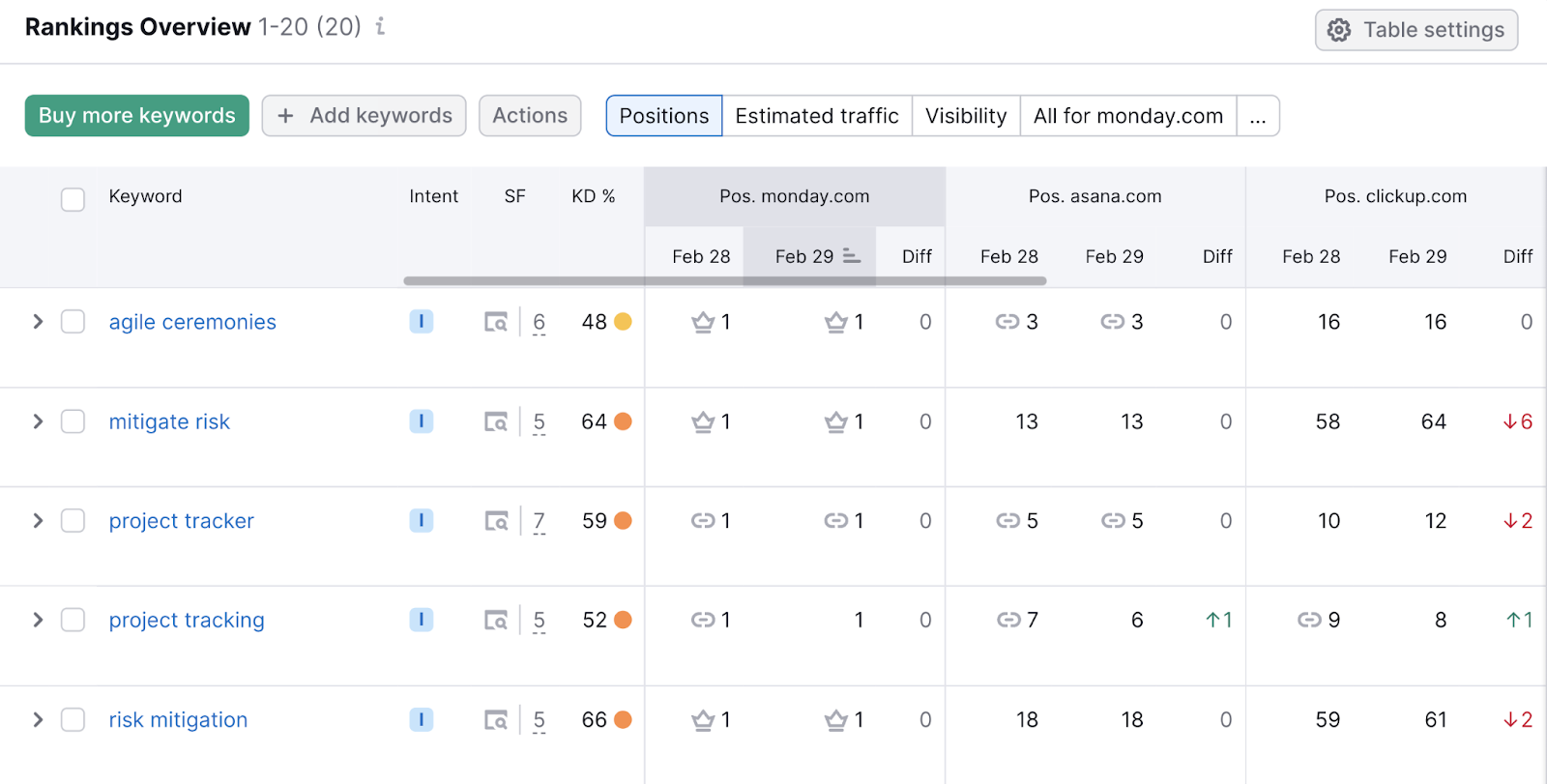
Greater key phrase rankings imply you will have higher visibility for related searches. Decrease rankings imply alternatives to enhance your SEO.
Share of Voice
Share of voice (SoV) measures your model’s visibility throughout channels in comparison with your opponents.
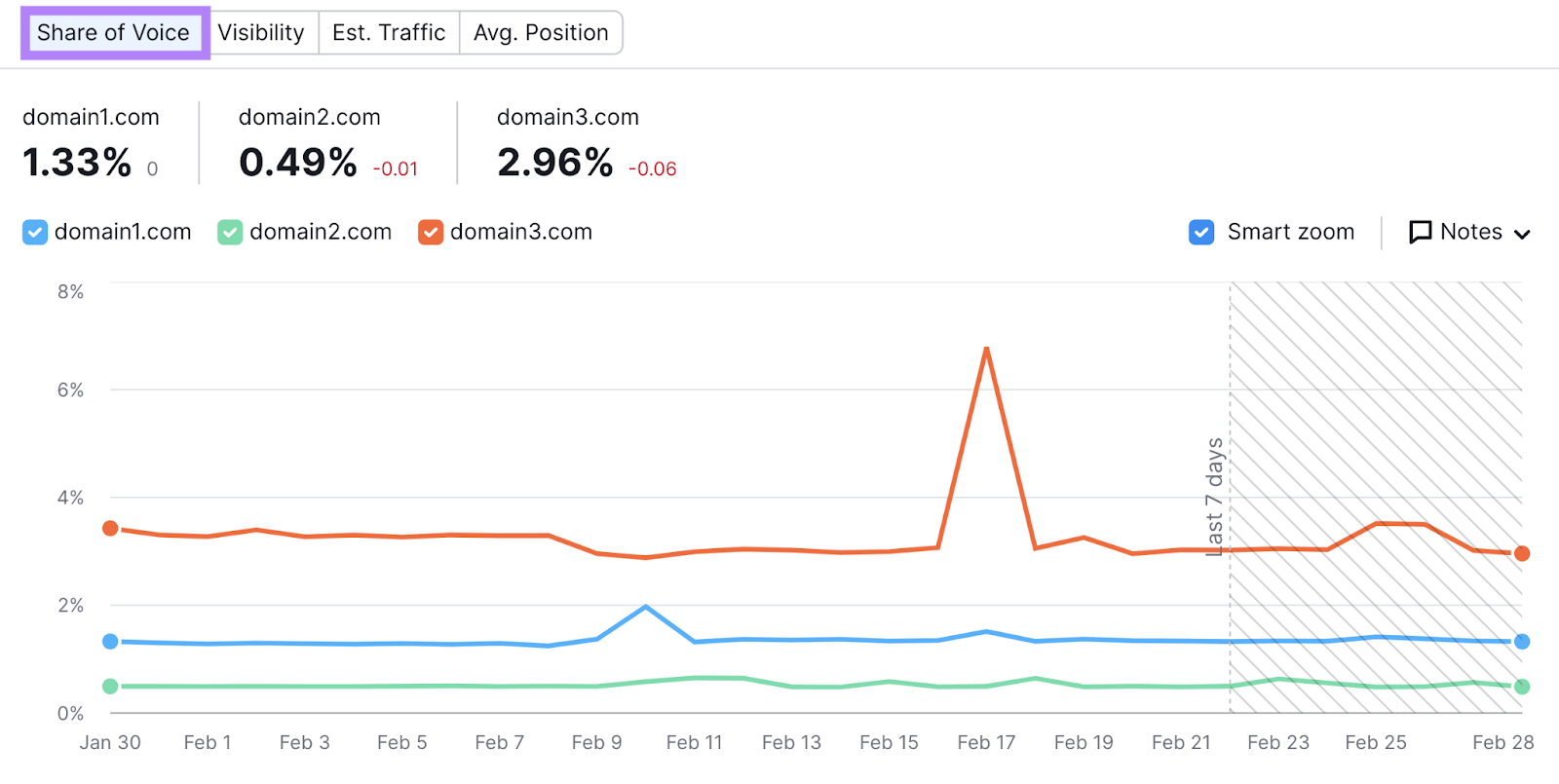
It takes into consideration your entire digital panorama—natural search, social media mentions, press protection, and so forth.
A better share of voice signifies that your model is extra prominently represented than your opponents.
Do Aggressive Benchmarking (Step by Step)
Now that you understand what particular metrics you must give attention to, let’s stroll by the benchmarking course of.
1. Establish Your Rivals
Make an inventory of three to 5 direct opponents in your business. These needs to be firms that supply very related merchandise/companies to your personal and goal the identical audiences.
For instance, if you happen to promote venture administration software program, your opponents might embrace Asana, ClickUp, Smartsheet, and so forth.
In the event you’re unaware of who your opponents are, use a instrument like Domain Overview.
Enter your web site URL and click on “Search.”

Scroll down, and also you’ll see an inventory of your opponents within the “Predominant Natural Rivals” part.
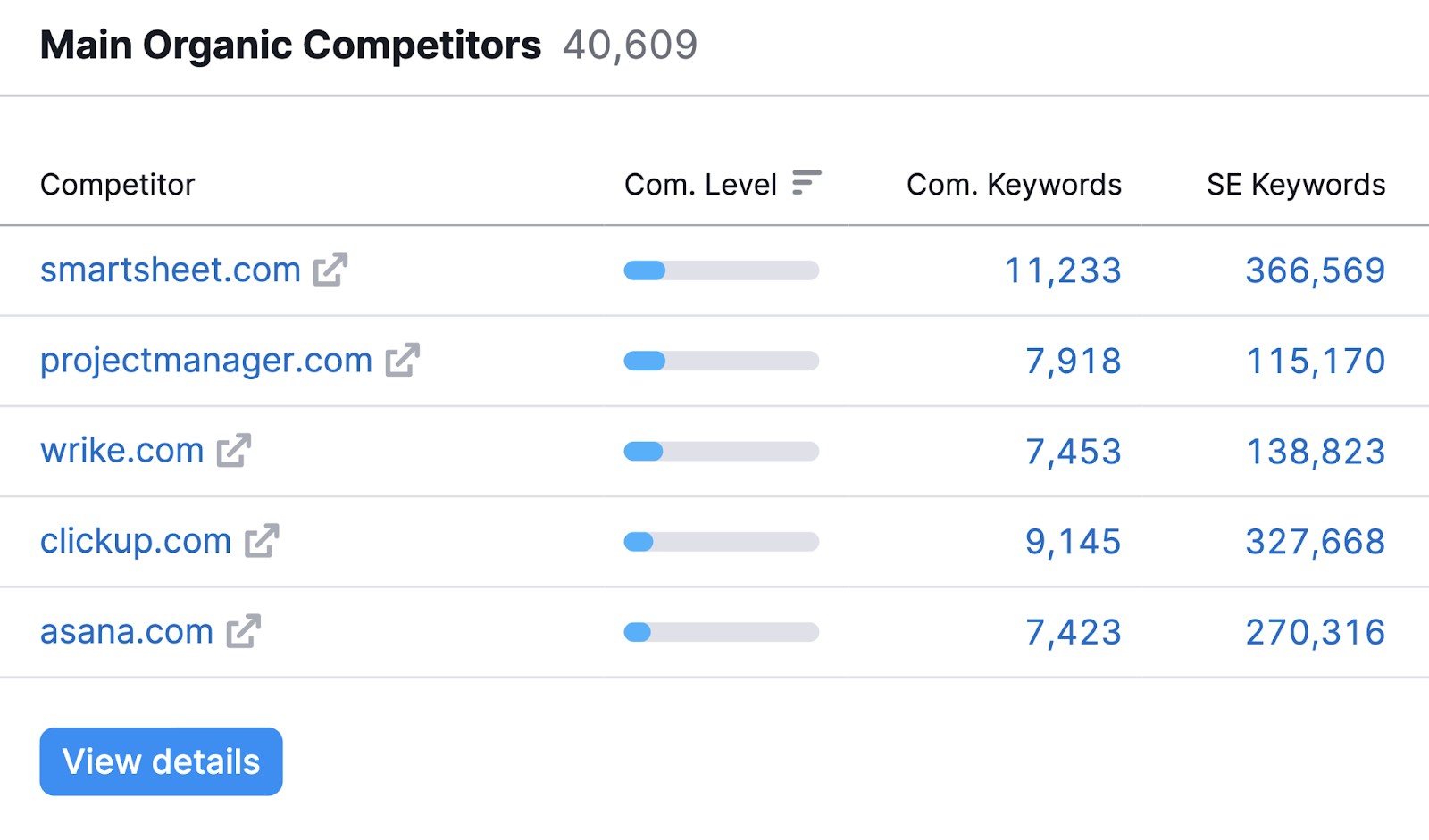
2. Discover the Visitors Share Break up
The subsequent step is to find out your share of the market’s net visitors.
To do that, use Semrush’s Market Explorer instrument.
Open the instrument, click on the “Discover Rivals’ tab, enter your area identify, and click on “Analysis a market.”

You’ll discover estimated visitors share percentages within the “Share of Visits” part within the “Area vs Market Dynamics” module.

On this instance, Monday has a 9.35% share of the market, Asana has 12.46%, Smartsheet has 7.63%, and Trello has 29.62%.
This offers you a benchmark to goal for. If you wish to change into the market chief, you may have to surpass Trello’s 29.62% share.
For this, you’ll want to develop your web site visitors. So give attention to advertising and marketing methods like search engine optimization (search engine optimisation) and pay-per-click (PPC).
3. Analyze Web site Visitors by Channels
Subsequent, dive into the particular web site visitors numbers for every advertising and marketing channel.
To do that, use Semrush’s Traffic Analytics instrument.
Open the instrument, enter your opponents’ domains, and click on “Analyze.”
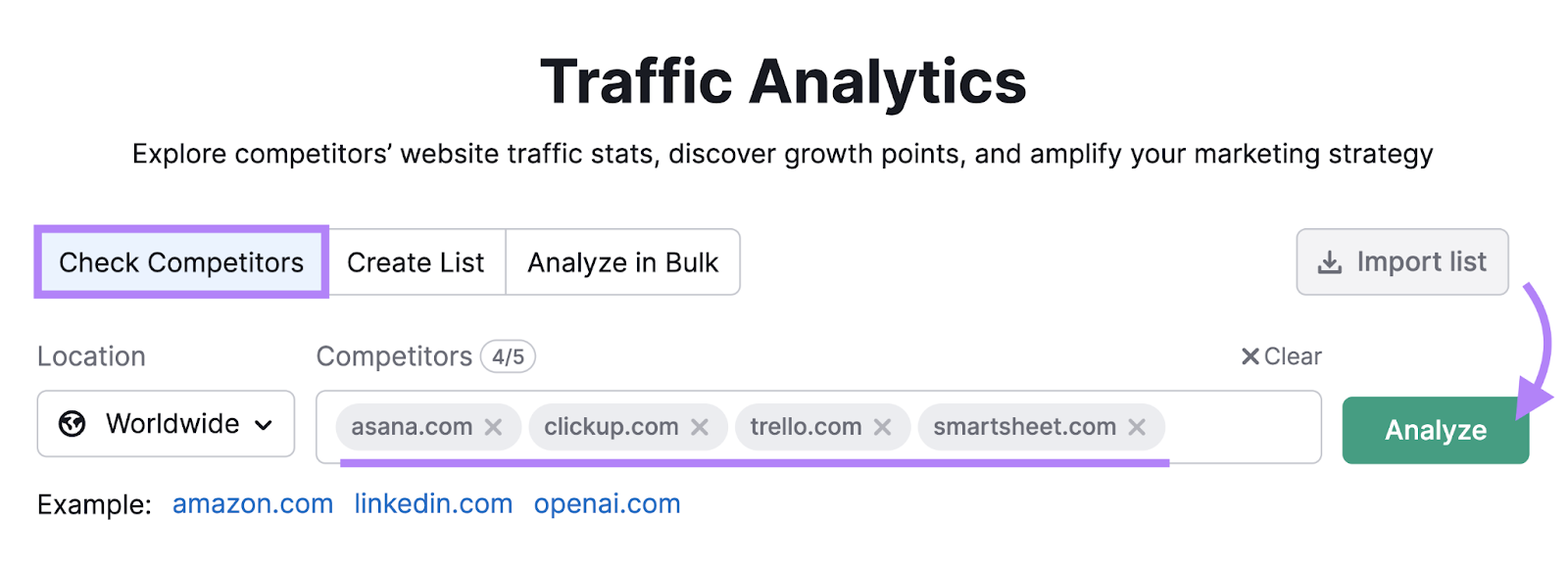
You may scroll down within the dashboard to see the visitors sources breakdown, which reveals the proportion of visitors coming from completely different channels, comparable to:
- Direct: Visits from customers who typed the web site URL instantly into their browsers or used a bookmark
- Referral: Visits from customers who clicked a hyperlink on one other web site
- Natural Search: Visits from customers who got here by engines like google’ natural search outcomes
- Paid Search: Visits from customers who got here by engines like google’ paid search outcomes
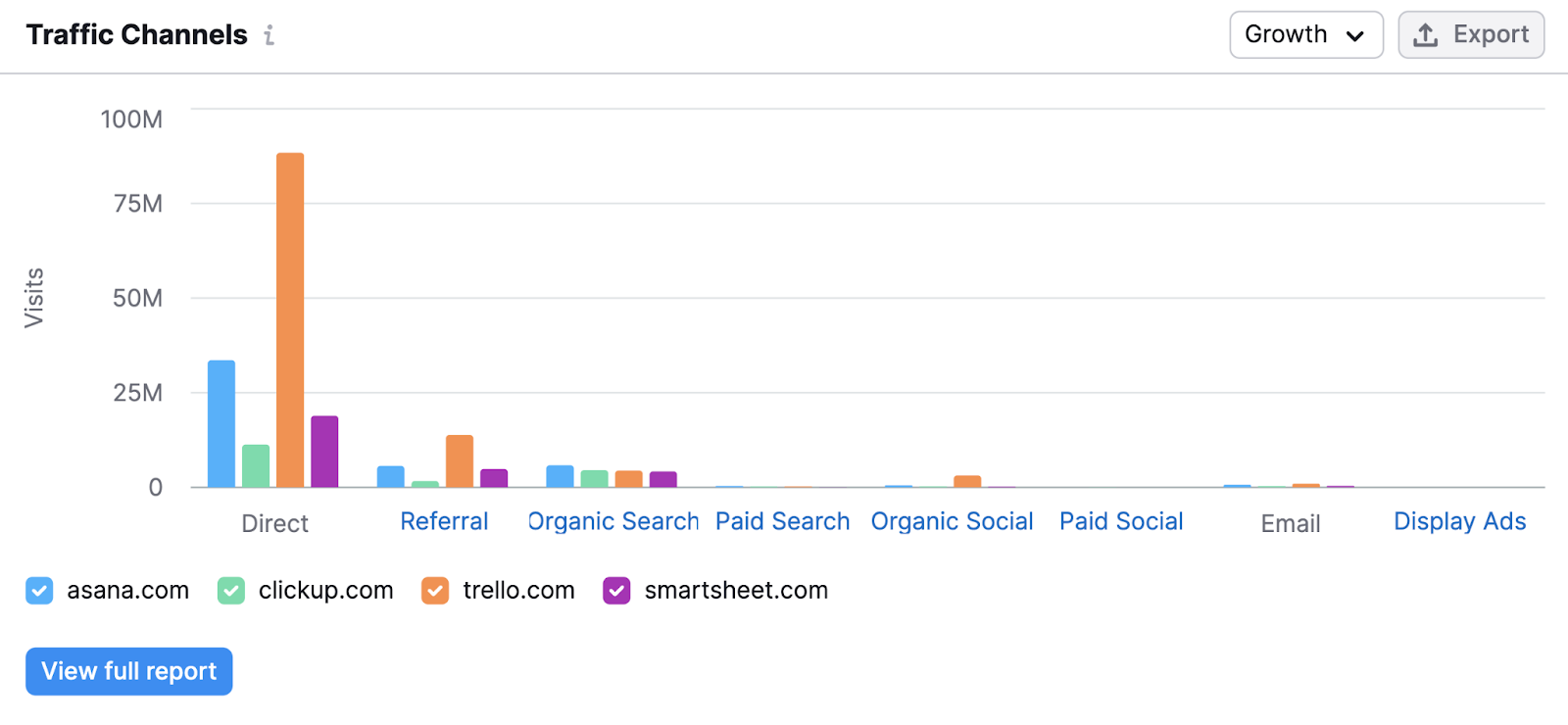
Now evaluate this information with the GA4 information in your web site. In GA4, go to “Reviews” > “Acquisition” > “Visitors acquisition.”
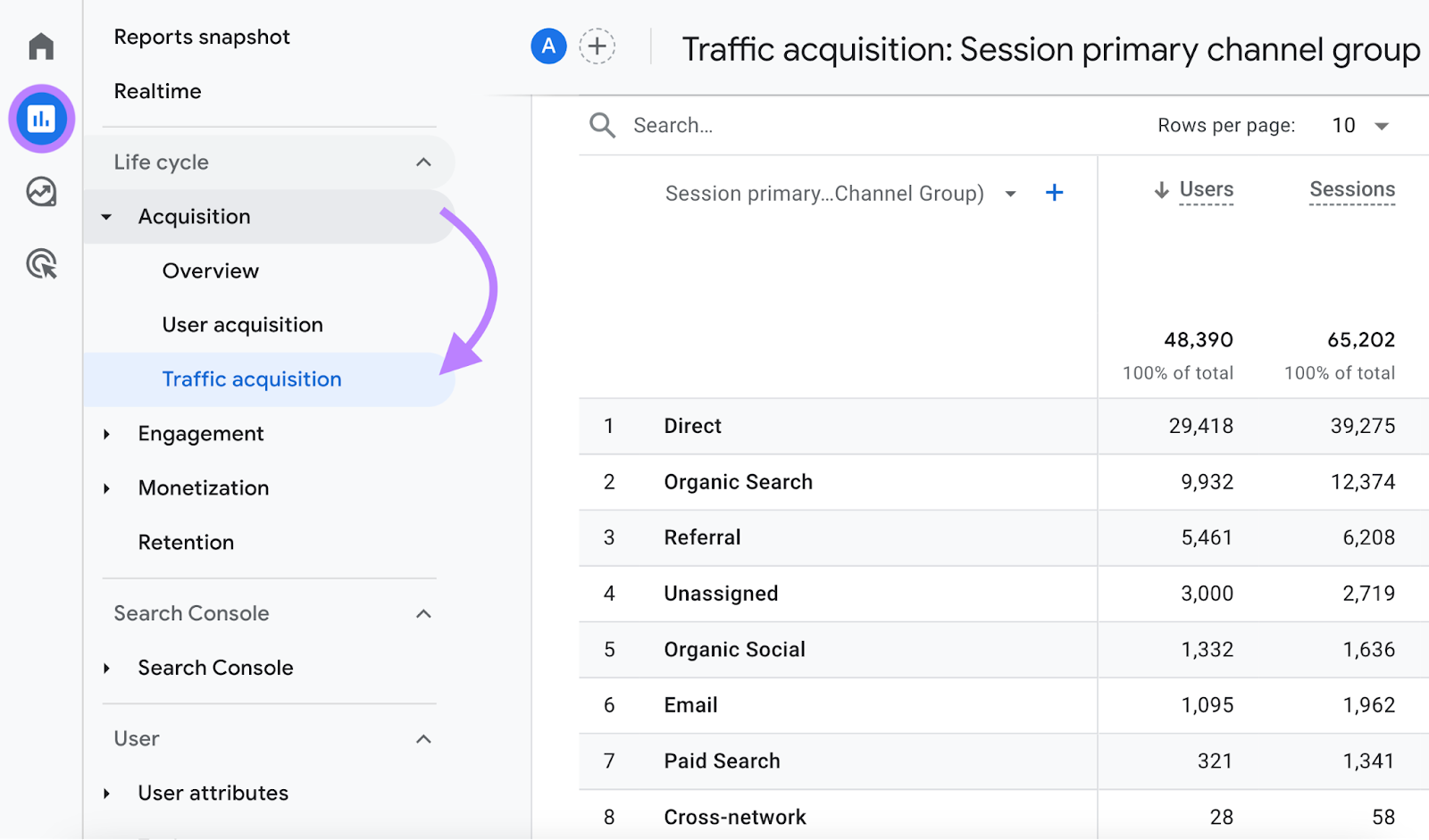
See how your visitors sources differ out of your opponents and whether or not there are channels you may need to use extra closely.
4. Test Social Media Followers
Now, have a look at your and your opponents’ social media followers throughout a number of platforms to see who has a much bigger viewers.
To do that, use the Social Tracker instrument (a part of Semrush Social).
When you configure the tool, it’ll present the variety of followers or followers you will have on every social media platform.
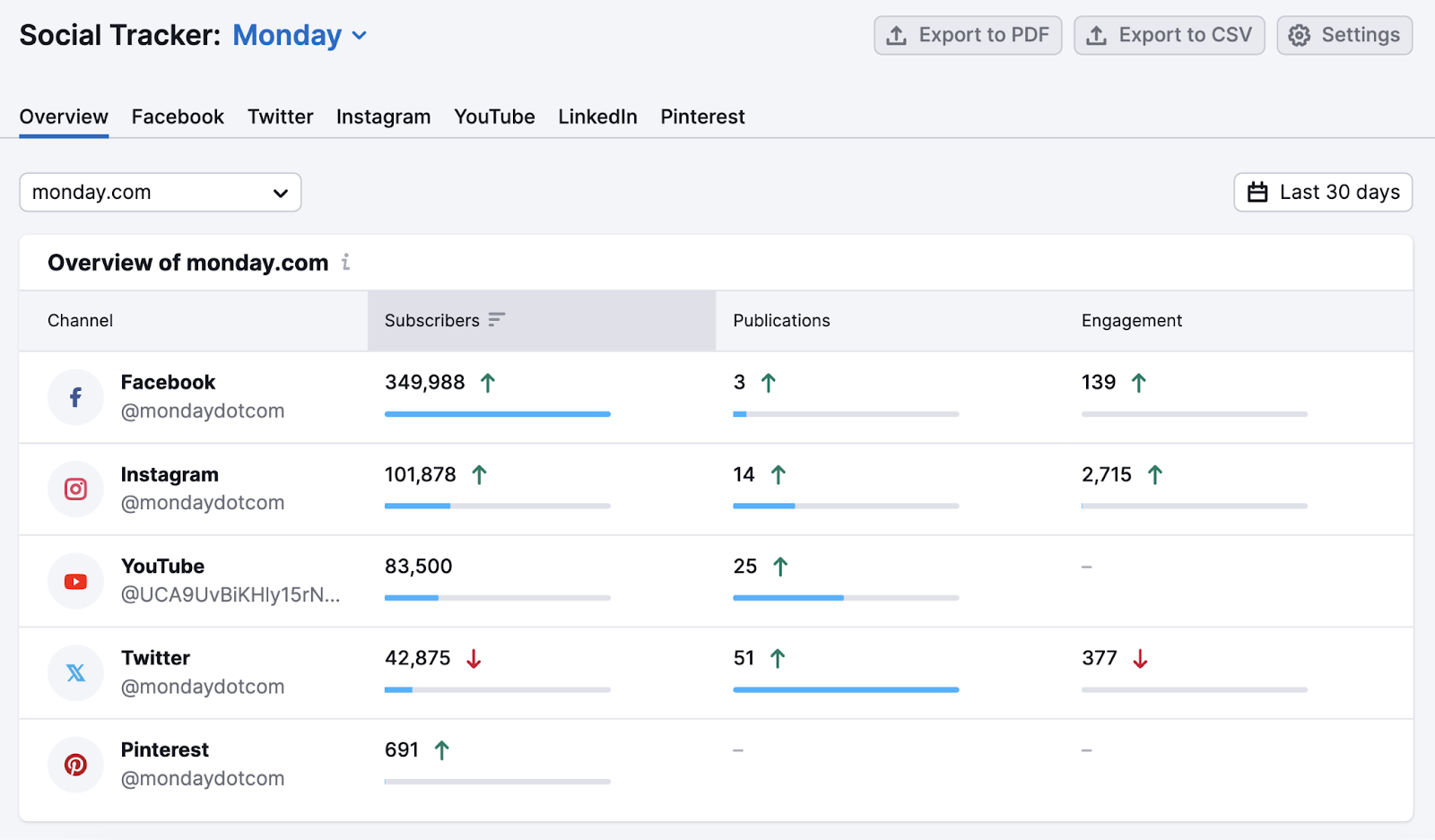
Examine your information side-by-side along with your opponents’.
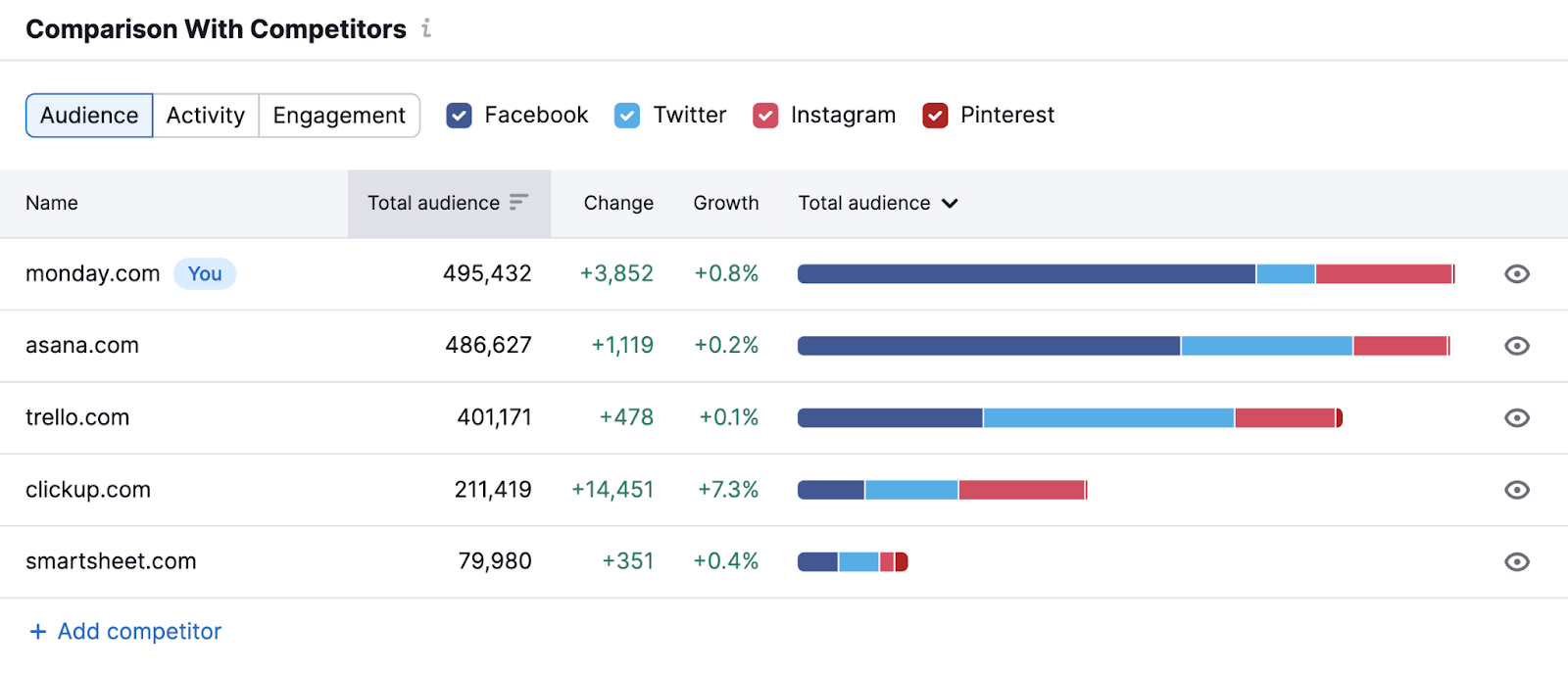
For instance, you might discover that your opponents have a bigger viewers than you on a sure platform. Which implies you might want to extend your attain and consciousness on that platform.
Learn our social media management information for recommendations on the best way to set your self up for fulfillment on social.
5. Analyze Key phrase Rankings
The subsequent step is to check your key phrase rankings along with your opponents to grasp the place you stand by way of search engine optimisation.
Use Semrush’s Position Tracking instrument to research key phrase rankings.
Set up a project within the instrument. Then, go to the “Overview” tab and click on on the “Add area” drop-down so as to add your opponents one after the other.
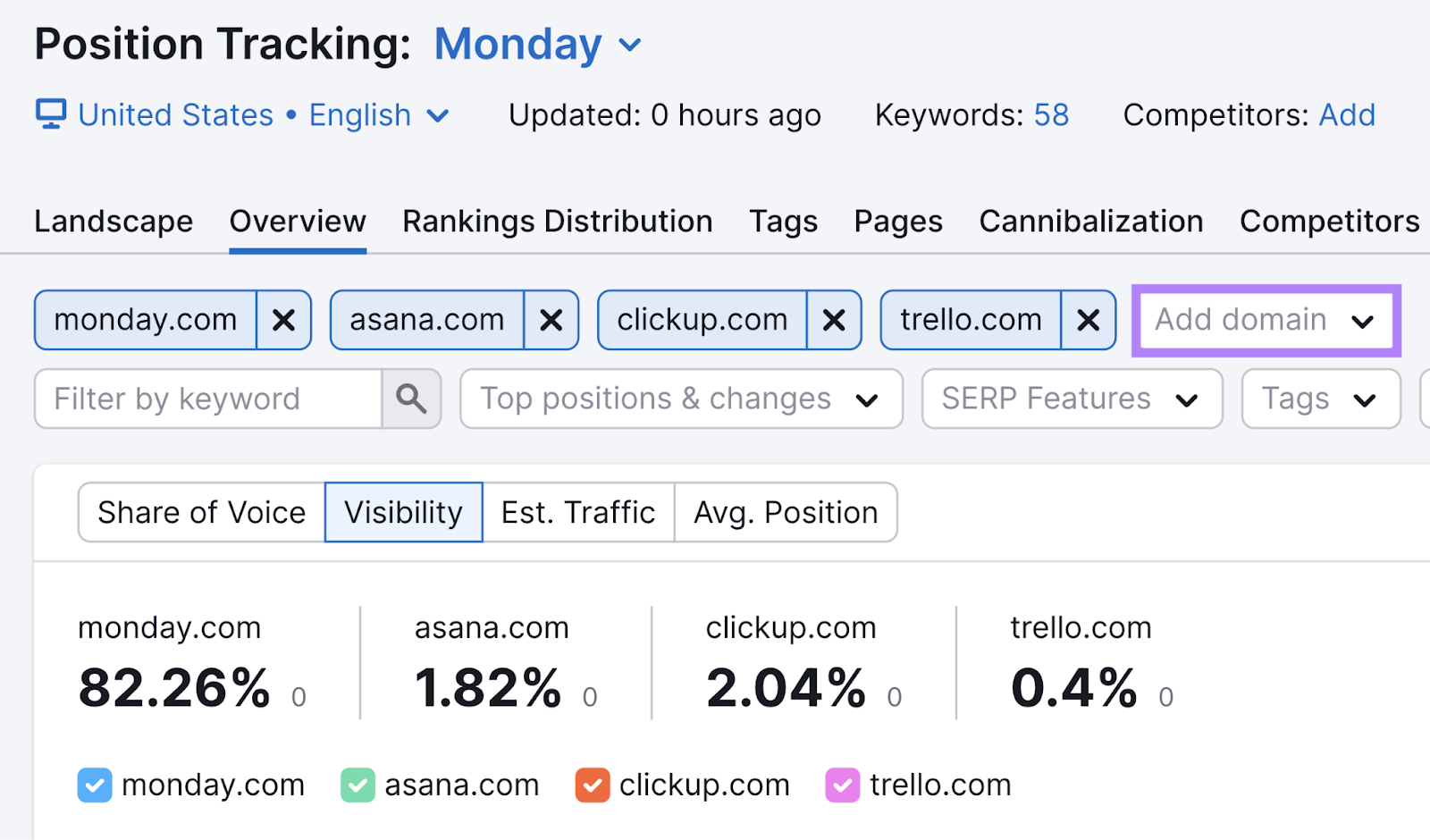
Then, navigate to the “Rankings Overview” desk.
Right here, you’ll see your and your opponents’ common rating positions for the tracked key phrases.
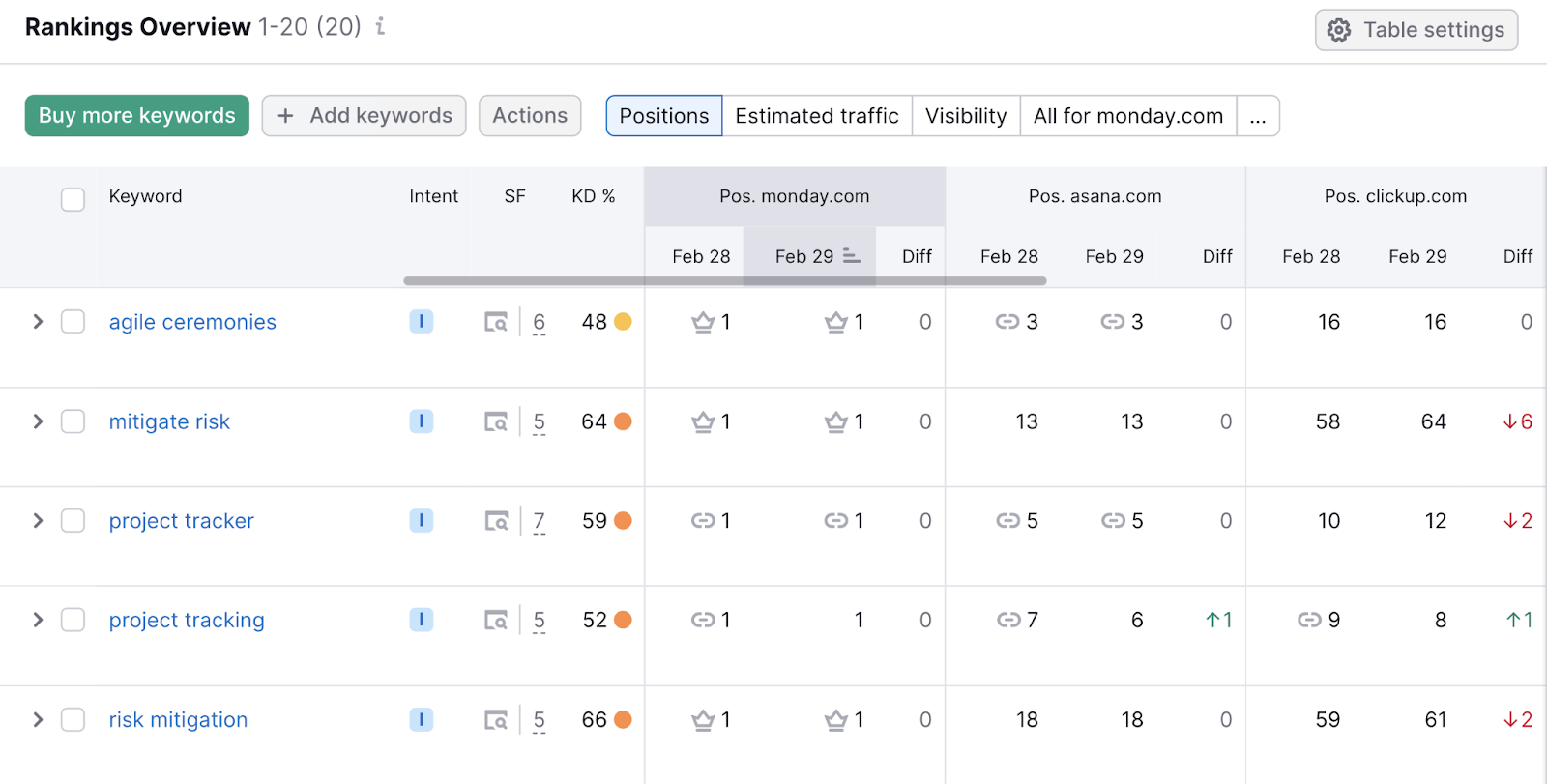
In the event you discover that your opponents rank larger than you for a lot of key phrases, meaning you in all probability have to rethink your search engine optimisation technique.
We’ve got a full information on creating an SEO strategy that can assist you get began.
6. Test the Share of Voice
Now, examine your share of voice to see how distinguished your model is in comparison with the remainder of your market.
To do that, you’ll want to arrange monitoring in your model and your opponents utilizing Semrush’s Brand Monitoring app. (Get began with this setup guide.)
This app will monitor mentions of your model and your opponents throughout the net, together with information websites, blogs, boards, and social media.
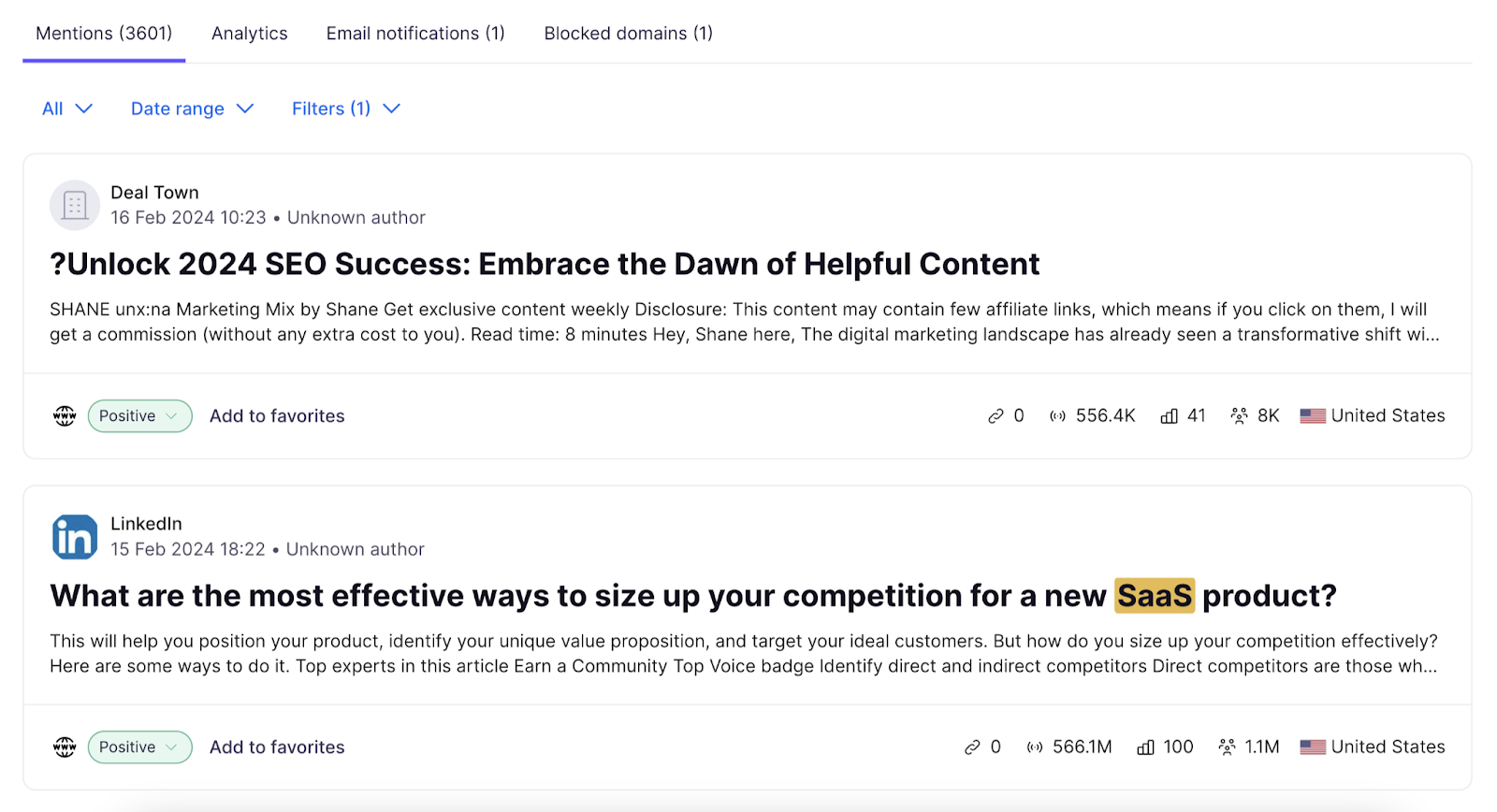
Then, go to the “Analytics” tab within the app and have a look at the SoV graph. This graph will present you the proportion of mentions that every model has in your market. You may also filter the graph by supply.

This fashion, you will get a holistic view of your SoV throughout completely different channels and see the way it modified over time.
You may also calculate SoV for particular advertising and marketing channels.
That is the formulation for calculating SoV:
SoV = (your model’s visibility on a specific channel / whole visibility out there on that channel) x 100
For instance, to find out natural search SoV, you’ll divide the quantity of visitors you get from related key phrases by the mixed month-to-month search quantity for these key phrases. And a number of by 100 to get a proportion.
Semrush’s Position Tracking instrument robotically stories this info to you:
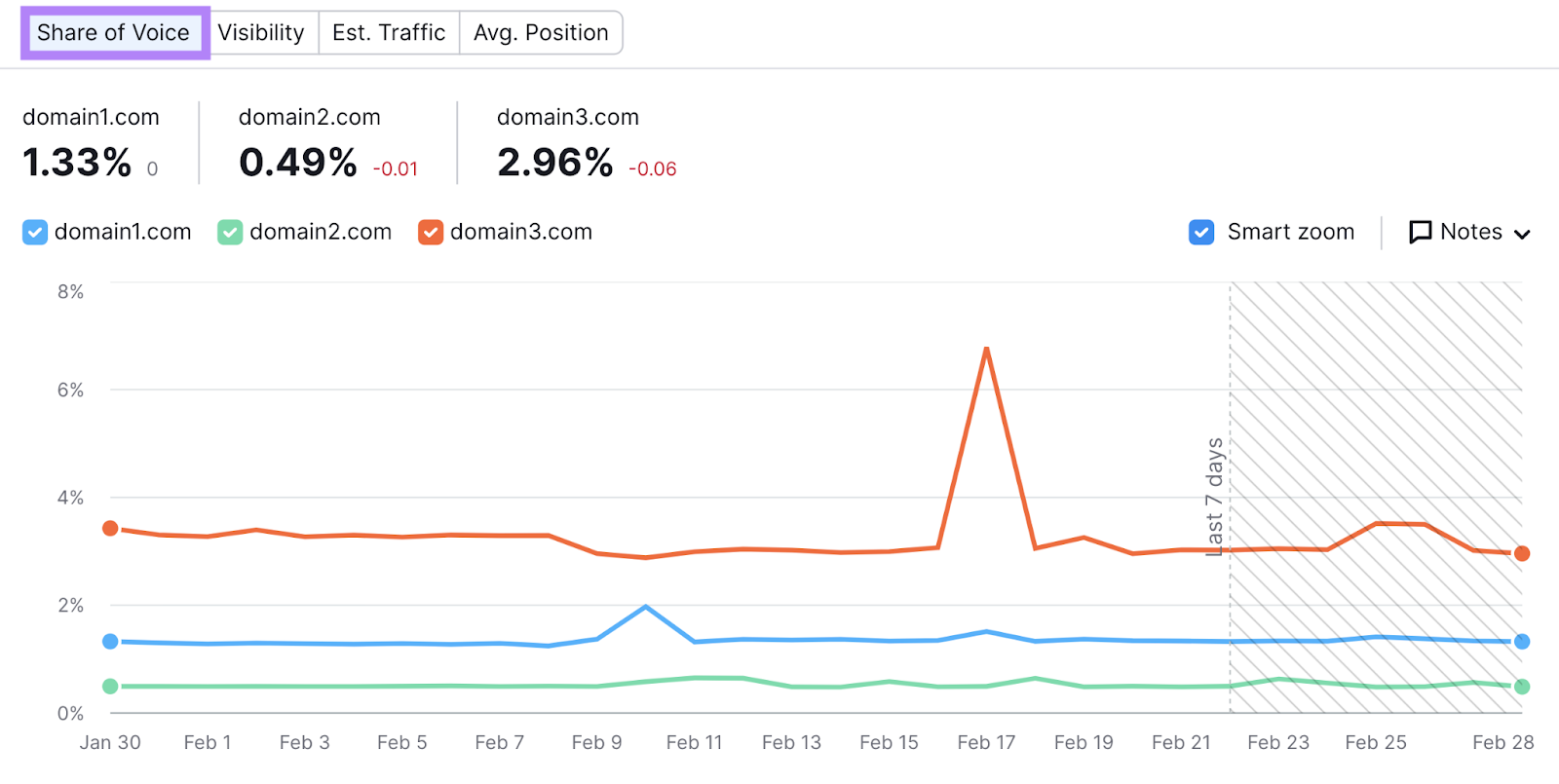
After analyzing the info, you might discover that your opponents have the next SoV than you. However you possibly can overtake them by implementing a strong on-line advertising and marketing technique.
Our digital marketing guide may help you with that.
Get Began with Aggressive Benchmarking
There are clearly quite a few advantages of aggressive benchmarking.
General, it provides you a clearer image of your business place so you may make the best strikes to change into a frontrunner in your house.
So, get began by benchmarking your self towards your prime opponents.
Semrush has a collection of instruments that may make it easier to by your entire course of.




